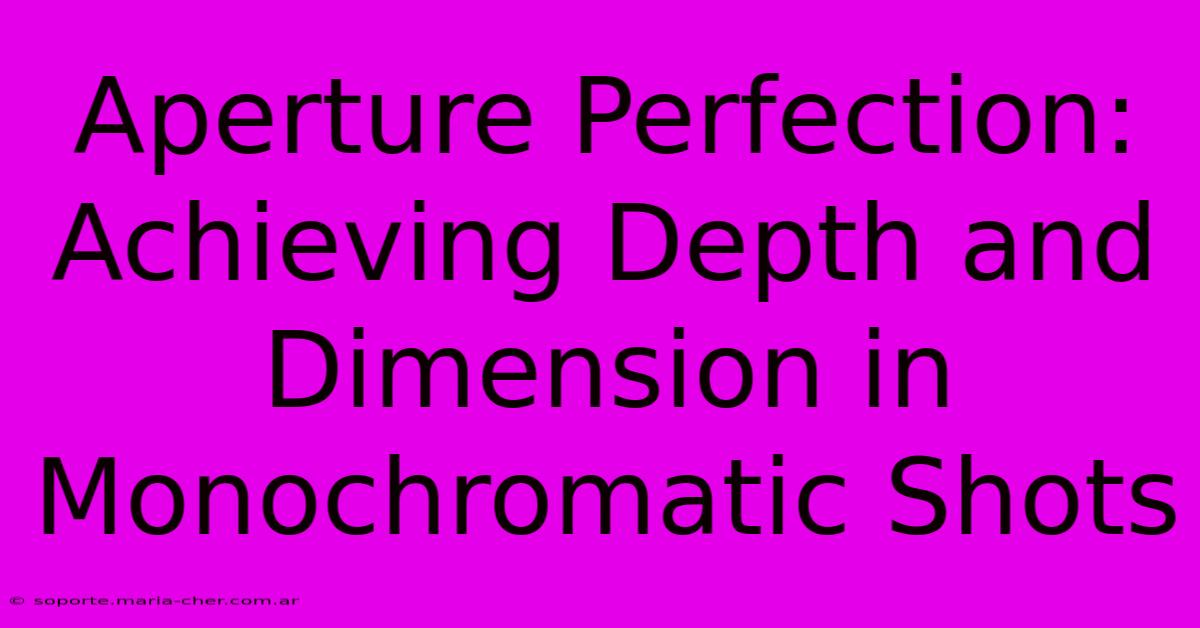Aperture Perfection: Achieving Depth And Dimension In Monochromatic Shots

Table of Contents
Aperture Perfection: Achieving Depth and Dimension in Monochromatic Shots
Monochromatic photography, with its stripped-back palette, offers a unique opportunity to explore texture, form, and light in a way that color photography sometimes obscures. But achieving depth and dimension in black and white isn't simply about converting a color image; it's about mastering your aperture and understanding how it interacts with light and shadow to build a compelling three-dimensional space within a two-dimensional frame.
The Power of Aperture in Monochrome
Aperture, controlled by your camera's diaphragm, dictates the amount of light entering the lens and directly impacts depth of field. This is crucial in monochromatic photography because the absence of color forces the viewer to rely even more on tonal variations and shadow play to perceive depth.
Wide Aperture (Small f-number, e.g., f/1.4, f/2.8): Shallow Depth of Field
A wide aperture creates a shallow depth of field, meaning only a small portion of the image will be in sharp focus. The rest will fall softly out of focus, creating a beautiful bokeh effect. This technique is excellent for:
- Isolating subjects: Draw the viewer's eye to a specific element by sharply focusing on it while blurring the background. This works particularly well with portraits or close-up shots of textured objects where you want to emphasize detail.
- Creating a sense of intimacy: The shallow depth of field can enhance a feeling of closeness and intimacy, drawing the viewer into the scene.
- Abstracting backgrounds: A blurry background can create an abstract, almost painterly quality, simplifying the composition and emphasizing the subject.
Example: Imagine a portrait of a weathered face, sharply focused, against a softly blurred cityscape. The shallow depth of field accentuates the wrinkles and texture of the face, drawing the viewer's attention and telling a story.
Narrow Aperture (Large f-number, e.g., f/8, f/11, f/16): Deep Depth of Field
A narrow aperture, on the other hand, yields a deep depth of field, keeping a larger portion of the image in sharp focus. This is perfect for:
- Landscapes: Capture the detail and texture of a vast landscape, from foreground to distant mountains, all in sharp focus.
- Architectural photography: Showcase the intricate details of buildings and structures, ensuring everything is crisp and clear.
- Street photography: Preserve the richness and context of a street scene, ensuring both near and far elements are in focus.
Example: A sweeping black and white landscape photograph, showing sharply defined rocks in the foreground, leading the eye to sharply focused distant hills and a crisp, cloud-filled sky, all contribute to a powerful sense of depth.
Mastering Light and Shadow in Monochrome
Light and shadow are paramount in monochromatic photography. The absence of color enhances the interplay of light and dark, creating dramatic contrasts that define form and texture.
- Side lighting: Use side lighting to create strong shadows and highlight textures. This technique is ideal for enhancing the three-dimensionality of objects.
- Backlighting: Backlighting can produce stunning silhouettes and ethereal highlights, adding a dramatic flair to your images.
- High-key vs. Low-key: Explore the contrast between high-key (bright, airy images) and low-key (dark, moody images) to create different moods and atmospheres.
Post-Processing Enhancements
While capturing the image correctly in-camera is key, post-processing can further enhance depth and dimension in your monochromatic photographs.
- Contrast adjustments: Fine-tune the contrast to emphasize tonal differences and create a more dramatic image.
- Dodging and burning: Selectively lighten (dodge) and darken (burn) areas of your image to enhance details and shape.
- Texture enhancements: Use tools to bring out the textures in your images, adding depth and visual interest.
Conclusion: Embrace the Nuances of Monochrome
Mastering aperture and understanding the interplay of light and shadow are crucial for achieving depth and dimension in monochromatic photography. By experimenting with different aperture settings and lighting conditions, and by leveraging post-processing techniques, you can transform your black and white images from flat representations into rich, three-dimensional experiences. So grab your camera, explore the world in shades of grey, and unlock the profound artistic potential of monochrome.

Thank you for visiting our website wich cover about Aperture Perfection: Achieving Depth And Dimension In Monochromatic Shots. We hope the information provided has been useful to you. Feel free to contact us if you have any questions or need further assistance. See you next time and dont miss to bookmark.
Featured Posts
-
Collation Demystified The Art Of Organizing Printed Pages
Feb 07, 2025
-
The Flowering Canvas Sakuras Branches As A Work Of Art
Feb 07, 2025
-
Swish Or Swish Out The Absurdity Of Funny Basketball Team Names
Feb 07, 2025
-
Cognitive Dissonance The Invisible Hand That Guides Your Decisions
Feb 07, 2025
-
Cheer Like A Champion Elevate Your Game With Oregons Top Cheer Signs
Feb 07, 2025
